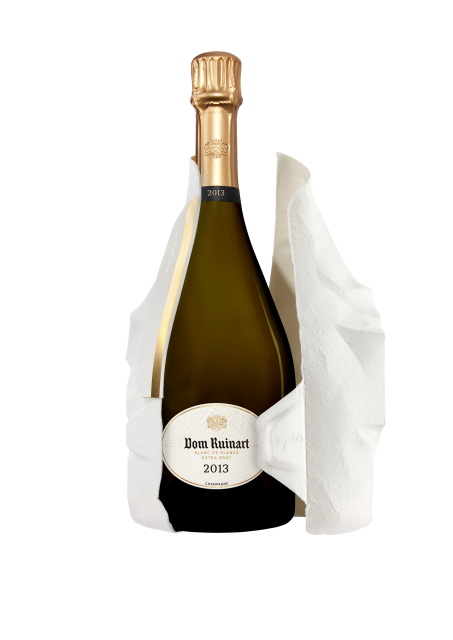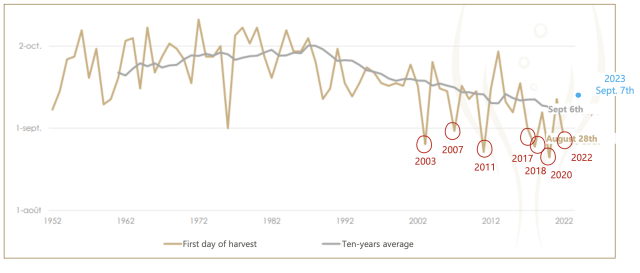This website uses cookies so that we can provide you with the best user experience possible. Cookie information is stored in your browser and performs functions such as recognising you when you return to our website and helping our team to understand which sections of the website you find most interesting and useful.
Why Dom Ruinart’s latest release is one to cellar
By Patrick SchmittThe latest vintage of prestige cuvée Dom Ruinart is being released next month, and its source harvest is so atypical, the Champagne house is holding back bottles as a record for the future.

Available in the UK from September, with a rrp of £230, the upcoming expression hails from a special year in the modern history of Champagne, not because it was a heatwave vintage, but a cool year, with conditions that harked back to a previous climatic era in the region.
The harvest is 2013, when the start to the year was cool and wet, delaying bud break and flowering by 13 and 21 days respectively, compared to the 10-year average, meaning that, despite a dry and warm August, harvesting started on 30 September, 20 days later than usual.
Heralded as an anomaly in Champagne this century, the temperature in the first six months of 2013 was the lowest recorded in 20 years – amounting to 7.7°C compared to a ten-year average of 10°C.
Speaking at the London-based launch of Dom Ruinart 2013 last month, cellar master Frédéric Panaïotis stressed the importance of this standout harvest.
Pointing out that it was unlike other vintages of this century, he compared 2013 to a famously cool decade in Champagne, commenting that “2013 is back to the 80s on so many parameters – everything was cooler and later.” (See bar graph, bottom).
Continuing, he said, “It’s the last one, and I hope we will see a vintage like 2013 in the future, but I doubt it – I don’t think we will see harvesting take place again almost every day in October.”
Then he said, “If I am to compare 2013 with a vintage of the past, then ’88 could be a comparison,” before describing the wines from 2013 as “bright, clean, crisp and Chablis-like.”
Due to the particular character of the vintage, and the atypical weather that produced it, Panaïotis urged collectors to keep some bottles in their cellars to serve as a record.
“Put some 2013 in your cellar, as I don’t think we will see another like it, and it’s why I am keeping quite a few bottles and magnums in the cellar as a reference for what a cool climate was like in Champagne,” he said.
Also remarking on the year’s unusual nature was Dom Pérignon cellar master Vincent Chaperon, ahead of the release of this prestige cuvée’s 2013 expression, which was unveiled last year.
“The 2013 is a vintage which now looks like a classic, it was an exception, because it was an October harvest, and perhaps the last one we will have; it is the last of the Mohicans,” he told db.
However, he also schooled against assuming that the resulting Champagnes were lacking in richness, commenting, “2013 is not as simple as you might think: it is a mix of a late-harvest vintage with the concentration that comes from a warm and very dry summer.”
Indeed, analysis by Ruinart has shown that the musts in 2013 reached a potential alcohol level of 9.9%, which was in line with the ten-year average, although the total acidity was nearly one point higher (8.4 vs 7.6 H2SO4 g/l) – indicative of a late harvest.
Dom Ruinart is a pure Chardonnay prestige cuvée, and the 2013 follows the 2010 vintage.
Panaïotis commented, “I didn’t make a Dom Ruinart in 2011, and I didn’t make a 2012 either – I loved the Pinot Noir from that year, but I never fell in love with the Chardonnay, so I skipped the vintage, and I sleep very well.”
Notably, the 2013 expression is the second Dom Ruinart vintage to be aged sur latte under cork – as opposed to crown cap – with manual disgorgement.
“Cork brings some flavours and tannin that you might associate with oak, and it brings less oxidative characters in the long term, so it tightens the wines,” he said, listing his reasons for choosing the closure for sealing the bottles of the prestige cuvée while it ages in Ruinart’s cellars.
Summing up on the effect of the stopper, he said, “So, 2013 [Dom Ruinart] is even more like a razor compared to what it would have been like under a crown cap.”
Dom Ruinart 2013: the facts
- Chardonnay from Grands & Premiers Crus:
- 70% from the Côte des Blancs: Le Mesnil-sur-Oger, Avize, Chouilly, Bergères-lès-Vertus
- 30% from the Montagne de Reims: Verzenay, Sillery, Taissy, Villers-Marmery
- Hand-harvested
- Alcoholic fermentation in temperature-controlled stainless steel tanks
- Malolactic fermentation
- Cork closure
- Manual riddling
- Ageing on lees: minimum 9 years
- Manual disgorgement
- Dosage: 5.5 g/l (extra-brut)
- Available for £230 from Clo19 and Jeroboams, Dom Ruinart 2013 will be available in the UK from September.

Related news
Is tirage under cork making a comeback in Champagne?

